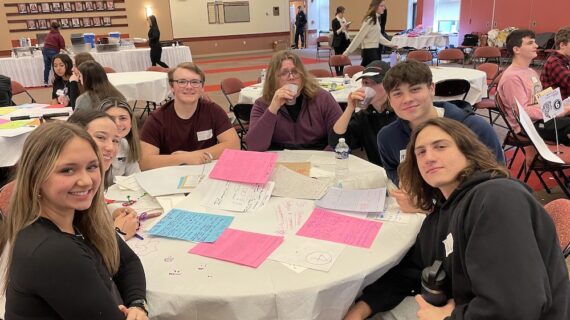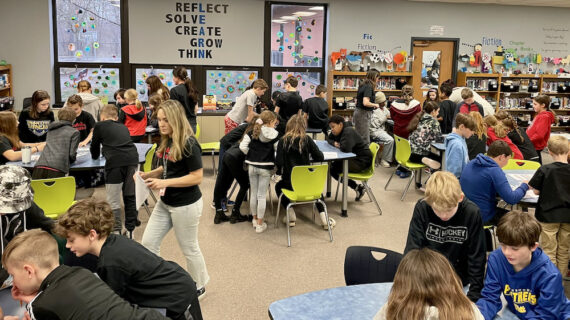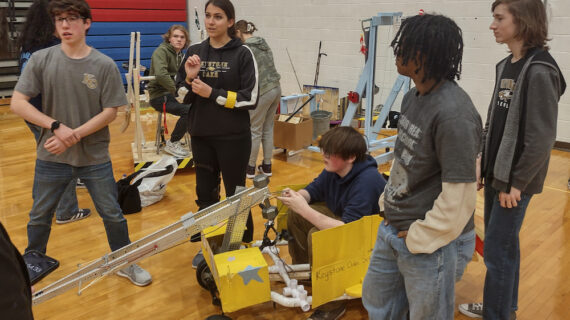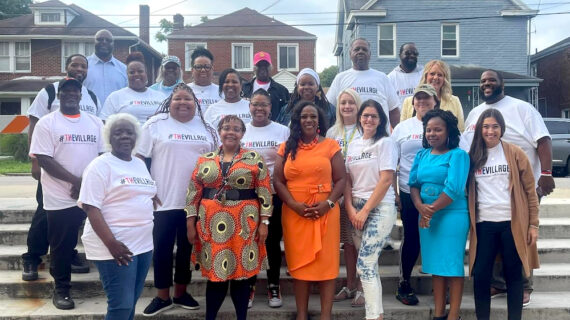
In the Crawford Central School District, enlisting — and supporting — allies in students’ learning
This story is one in a series created in collaboration with the AASA Learning 2025 Alliance to celebrate the work of groundbreaking school districts in the Pittsburgh region. Kidsburgh will share these stories throughout 2024.
Wally Mason retired from his classroom, but not from his community.
After a career spent teaching children, he turned to volunteering and nonprofits near Meadville, Pennsylvania. “One thing I learned in that work,” he says, “is that there are many people in our community who struggle with reading. So I thought, ‘Well, I’m a former teacher. Maybe I can do something.’”
Mason and his colleagues offered help for parents and caregivers — the adults who, properly equipped, would be able read to young learners at home. But there was just one problem: No one showed up for help.
“In retrospect, I can’t blame them,” says Mason. “It’s really, really tough for adults to say, ‘I struggle with reading.’ You get good at hiding it after a while. And to come in and ask for help — well, that’s really embarrassing and a difficult thing to do.”
Ever the educator, Mason had an idea. “I said, ‘You know, maybe we should work directly with the schools. If we can work with students who are struggling, we can help prevent [literacy] problems while the kids are still young.’”
That’s how he found himself at the Crawford Central School District — the same district from which he’d retired.
His timing couldn’t have been better. In the decade since he’d retired, Crawford Central had joined the Western Pennsylvania Learning 2025 Alliance, a regional cohort of school districts working together — with support from The Grable Foundation — to create student-centered, equity-focused, future-driven schools. Led by local superintendents and AASA, The School Superintendents Association, the Alliance convenes to help districts like Crawford Central do what they do best: prepare every learner for tomorrow.
“It’s been a tremendous opportunity for us to collaborate with other districts,” says Tom Washington, Crawford Central’s superintendent (now retired). “Together, we’ve been able to ask: How do we not only get education up and running again [after the pandemic], but also make our schools even better than they were before?”
The answer, in Crawford Central, turned out to be family and community engagement. A key pillar of the district’s strategic plan, Crawford Central’s focus on families has paved the way for unprecedented partnerships with parents, caregivers, and community members, many of whom are — like Wally Mason — willing and eager to support the district’s students.

With help from Ann Noonen, the district’s director of technology integration and community outreach, Crawford Central has systematically eliminated the barriers that had kept families out of schools. They have created a one-stop shop where parents and caregivers could obtain required clearances, tuberculosis tests, and more. The district even covered families’ costs, ensuring that anyone who wanted to help would be able to do so.
Then, says Washington, “we took what we learned from working with families and we applied it to working with people from the community,” including Mason and his band of volunteers.
They call themselves the Reading Allies. In addition to Mason, the group includes a trained psychologist, a handful of retired teachers, and several people whose workplaces — including the local YMCA — are willing to let them work in Crawford’s classrooms for a couple of hours per week.
“The district made it incredibly easy for us to get clearances and everything else we needed,” says Mason. “They had everything set up and ready to go when we got there. Everything worked without a hitch.”
The district didn’t stop at clearances, either. “We make sure our volunteers can get comfortable working in schools,” Noonen explains. “We walk them through the buildings, introduce them to principals and reading specialists, and show them everything from where they’ll be working to where they can put their coats. We want them to know they’re welcome here.”
Most importantly, the district suggested that retired reading specialists Fritzi Kloecker and Sheree Auell lead the Reading Allies through an eight-week course on Orton-Gillingham — a proven, multisensory approach to teaching phonemic awareness and other essential reading skills.
Funding for this program came from an Allegheny College grant awarded to local nonprofits Creating Landscapes, Food4Thought, and Reading Allies. Monies covered workshop expenses. Meadville Kiwanis also contributed to the project by helping with supplies, and the training was held at Family Community Christian Association.
It was during this training, Mason recalls, that he knew he’d made the right choice. “I realized, ‘This is really valuable. I’m really happy I joined this group.’”
The kids are happy, too. Today, the Reading Allies work with students in kindergarten through third grade — the most critical years for budding readers. “The first two students I worked with had a bit of trouble with speech,” says Mason. “Remember, for a long time [during the pandemic], they hadn’t had much contact with other students.”
But as he led them through the Orton-Gillingham approach, Mason watched the students’ struggles gradually fade away. “I’d tell them, ‘You’re fantastic! The more you practice something, the better you become!’”
That’s exactly the goal, says Noonen: repeated practice, marked progress, and new connections in students’ brains. And while Reading Allies is still a young program, she says, “our students are really excited about it. So are our teachers.”
And so are volunteers like Mason. A decade after leaving the district, the retired teacher is thrilled to be back at Crawford Central.
“It felt like a little homecoming,” he says. “The kids are so happy to see me. I always tell people: If you’re feeling down, go in and sit with these students for a while. They’ll cheer you right up.”
Want to download this story? Click here for a PDF.










